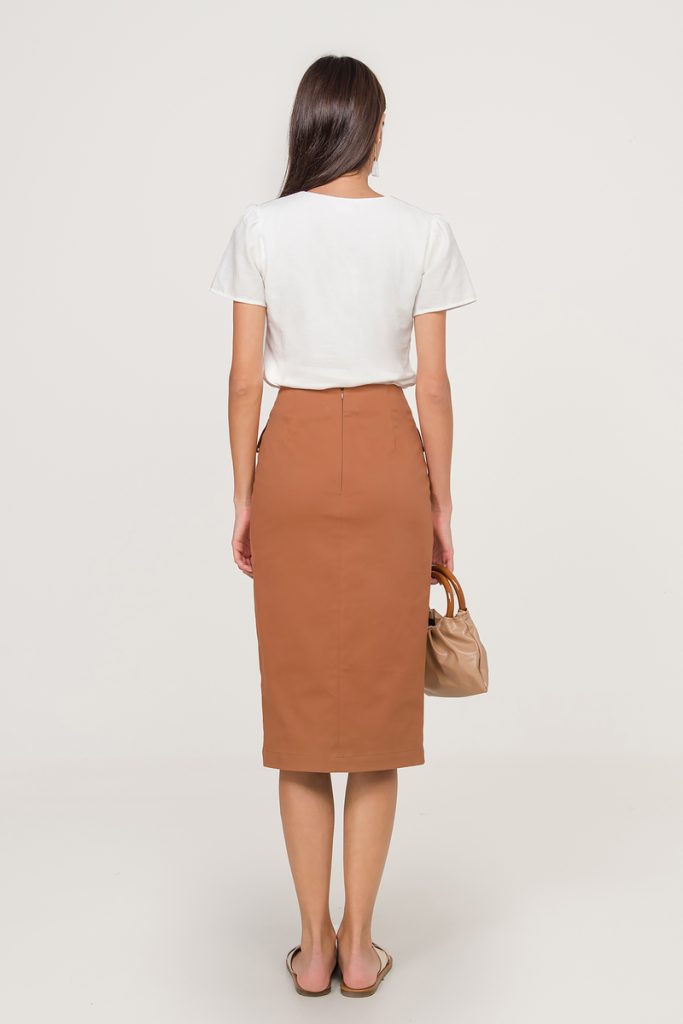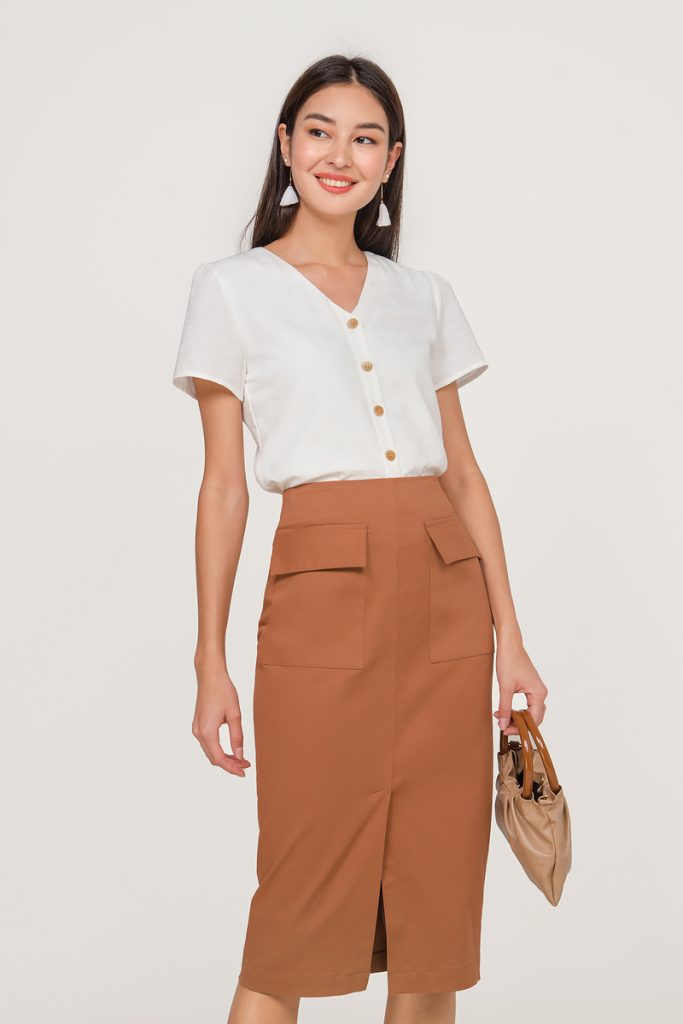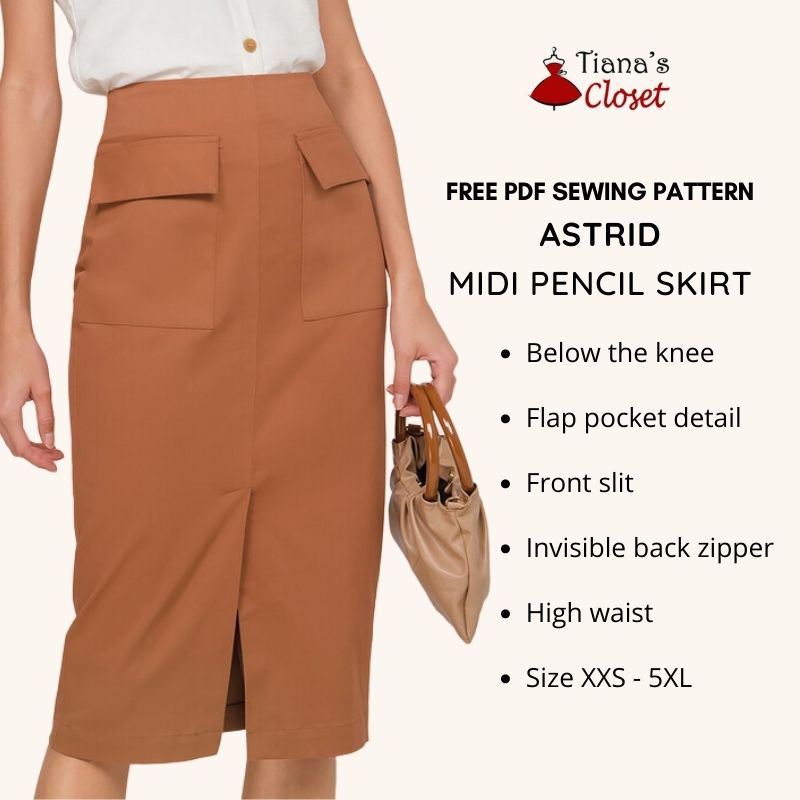The free pdf sewing pattern I am sharing today is the Astrid midi pencil skirt. It is just another basic pencil skirt, spiced up with added accent from the oversized flap pockets and a slit at the front. The Astrid skirt is a versatile piece that can be dressed up or down depending on the occasion. It’s a flattering silhouette that hugs the curves and accentuates the waistline. There are many ways to style a midi pencil skirt, depending on the occasion and personal preferences. Here are a few ideas:
- Dress it up with heels: A midi pencil skirt can look very chic when paired with high heels. Choose a pair of pumps or strappy sandals to elongate your legs and add some sophistication to the outfit.
- Go for a casual look with sneakers: If you want a more relaxed look, pair your midi pencil skirt with a pair of sneakers. This can be a great way to dress down the skirt and make it more suitable for everyday wear.
- Add a crop top: A crop top can be a great way to balance out the longer length of the skirt. Choose a top that’s fitted and sits just above the waistband of the skirt for a flattering look.
- Layer with a sweater: A midi pencil skirt can look great when paired with a cozy sweater. This can be a good option for cooler weather or for a more casual look.
- Tuck in a blouse: For a more professional look, tuck a blouse into the waistband of the skirt. This can be a great option for the office or for a more formal event.
- Add a denim jacket: A denim jacket can be a great way to add some edge to your midi pencil skirt. This can be a good option for a more casual look or for an event where you want to add some personality to your outfit.



My free pdf sewing pattern is made in 10 sizes from XXS to 5XL so you may find a suitable size for yourself. If you are not sure which size suits you best, take a look at the measurement table before doing anything here: SIZE GUIDE.
The pattern is made using layered PDF, please check for your desired size before printing so you won’t waste your paper. I have included a first page with many details about sizing and printing, so please first read the first page and make sure you know what size you need! If you still do not know how to print a layered PDF, please check for the printing instruction in this post: PRINTING GUIDE.
You can print this using your home printer and A4/Letter paper. I calculated the printing area so that you will be able to use either type of paper to print the pattern out perfectly. Always print the first page first and check with the test square if you are printing at the right scale before you print out the whole pattern – avoid waste of ink and waste of paper, save the earth!
Some PC may print smaller than actual size even when you choose 100% scale – I don’t know why this problem exist, but my HP laptop cannot print true to size. I have to scale up to 103% to get the right size. You may need to check with your PC to see if it prints true to size, if not, scale up a bit.
SEWING INSTRUCTION
You will need
- Fabric of your choice. This pattern is made for woven fabric.
- Invisible zipper
- Fusible interfacing (light weight)
- Scissors, pencil or fabric marker, ruler, pins
- Sewing machine/Serger or needle and thread
- Printed pattern
How much fabric do you need for this piece of garment? To be precise, you may need to check how much fabric you need before buying. It will depend on the selected pattern size, the width, and design of the fabric you plan to use. Just to be sure, print all the paper patterns and lay them out at the width of fabric you plan to use (usually from 90 to 150 centimeters or 35 to 60 inches). Measure how much fabric you will need. Don’t forget to account for pieces that need to be cut multiple times and pieces that are cut on the fold.
Cutting instruction:
After printing out and taping all the pattern pages together, you will get something similar to this image:

You will see that there are 2 sets of lines on each pattern size. The inner lines are sewing line (and you sew along these lines), and the outer lines are cutting lines (you cut the fabric along these lines, remember the folding lines where you have to fold the fabric before cutting). The distance between sewing line and cutting line is seam allowance, and it varies from point to point. For example, the side seam allowance is about 1/2 inch (1.2cm), and seam allowance at hemline is 1 inch (2.5cm). This is the reason why I do not remove the sewing lines from the pattern. Please use it as a guide to know how much seam allowance you need to give at each seam.
Fabric will be cut into following pieces:
- Back: cut 2
- Front: cut 2
- Pocket: cut 2
- Pocket Flap: cut 2 on the fold
- Front Waistband Facing: cut 1 self fabric + 1 fusible interfacing
- Back Waistband Facing: cut 2 self fabric + 2 fusible interfacing
Make sure to mark all notches and other design features such as darts, pleats etc. from the pattern pieces onto your fabric. When sewing the garment, pay attention to notches, they must match up.
Sewing instruction:
1. Serge/zig zag stitch the raw edge to prevent fabric from unraveling.
2. Apply fusible interfacing to Front Waistband Facing and Back Waistband Facing pieces.
3. Fold, pin and sew waist darts on Back pieces.
4. Hem the opening of the Pocket pieces. Attach the Pocket piece to the Front skirt. You can see how the pocket is attached in the following video that I found on Tiktok.
5. Fold the Pocket Flap piece so the right side is inside. Sew the two short ends. Trim the corner and turn the Pocket Flap over. Press and staystitch around the Pocket Flap.
6. Lay the Pocket Flap flat on the right side of the Front piece, the raw edge of the Flap is aligned with the opening of the Pocket. Sew to attach the Pocket Flap to the Front piece. Trim the seam allowance of the Pocket Flap to ¼ inch (5mm). Turn the Pocket Flap over so that it covers the seam allowance and overlaps the Pocket. Stay stitch the Flap to the Front piece to hide the seam allowance and keep it in position.
7. Place the Front skirt pieces right side facing, pin and sew the center front seam. Fold the kick pleat to one side and sew to secure it to position.
8. Place the Front Skirt and the Back skirt right side facing, pin and sew the side seam. Repeat with the other side. You get the main garment.
9. Place the Front Waistband Facing and Back Waistband Facing right side facing, pin and sew the side seam.
10. Place the Waistband Facing and main garment right side facing, matching the notches. Pin and sew to attach the waistband facing to the main garment.
11. Turn the Waistband facing in, staystitch the seam allowance to the waistband facing piece.
12. Attach invisible zipper to the back of the skirt and finish the center back seam.
13. Hem the garment.
Although it is a bit of a challenge sewing the pockets, I believe with some practice you will be able to make this gorgeous Astrid midi pencil skirt!
Now if you are interested in making this skirt, here is the download link:
ASTRID MIDI PENCIL SKIRT (SIZE XXS-5XL)
Click on the link above, you may see and ad pop-up but just close it and proceed with your download (sorry for the annoying ad but this is my best way to maintain the website – thanks for your understanding!)
Happy sewing! And don’t forget to share your project on my Facebook page: Tiana’s Closet Sewing Patterns
Tiana

